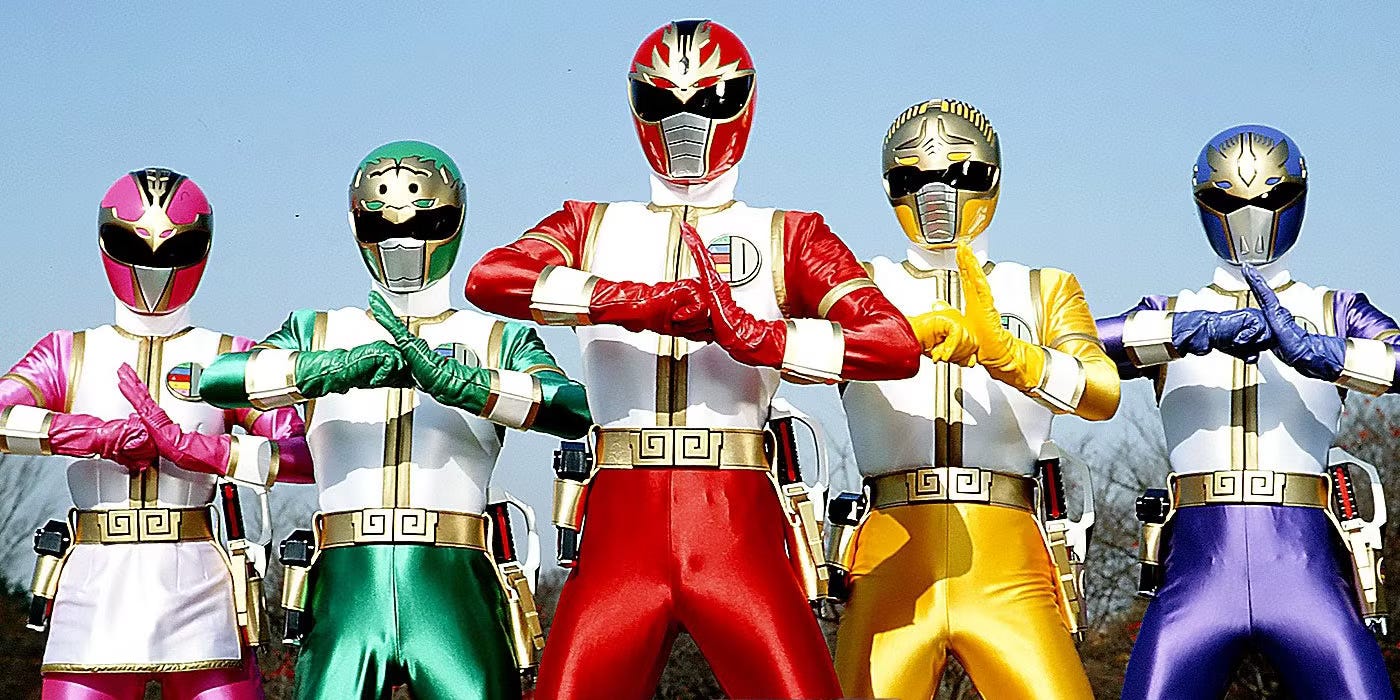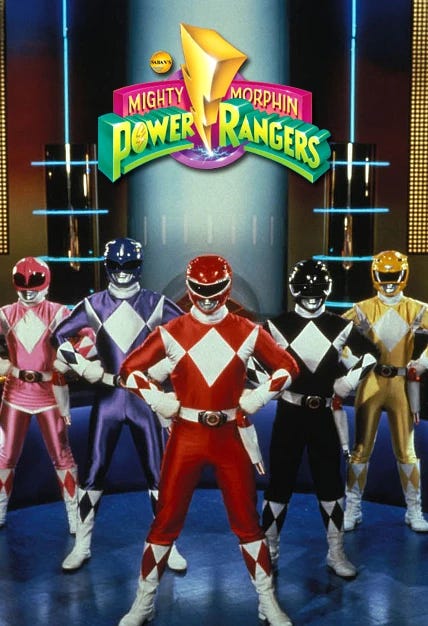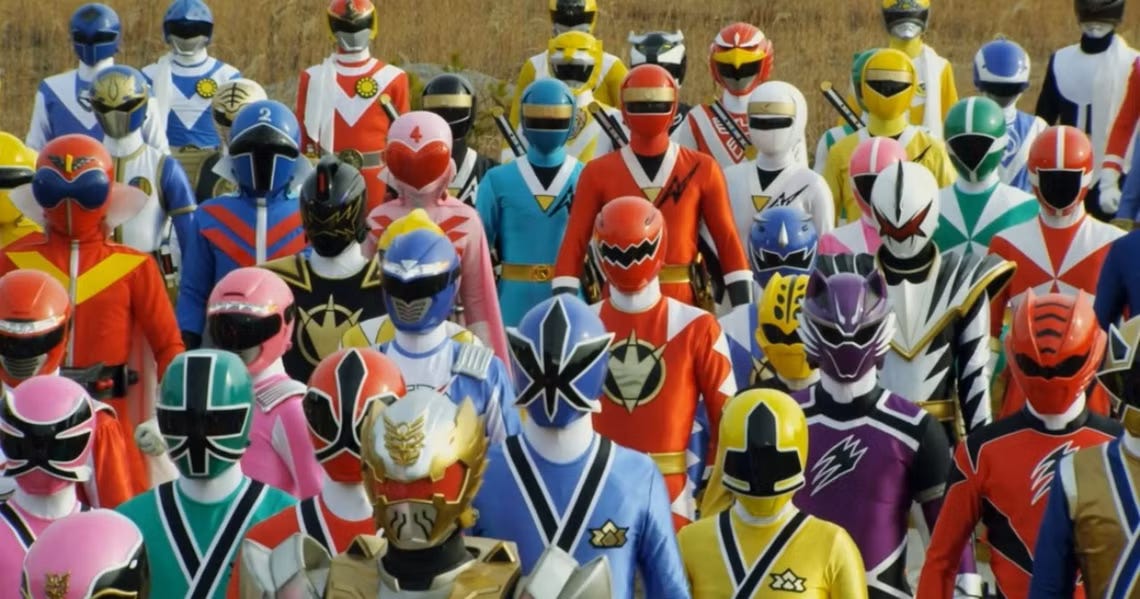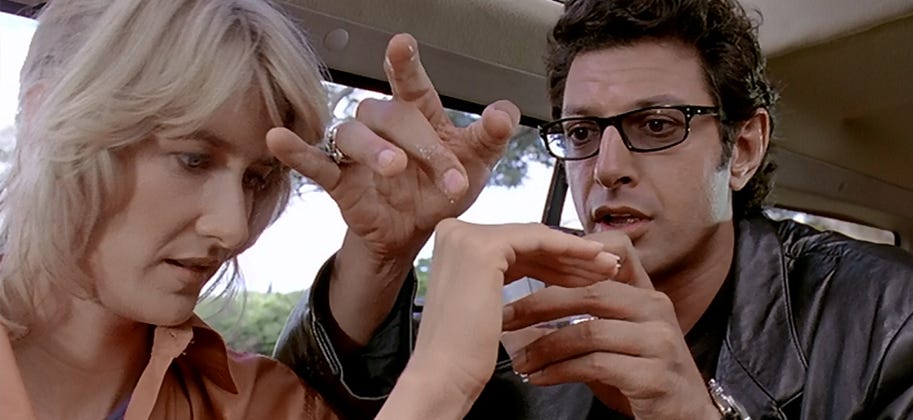Super Sentai, Part 1: In the Shadow of Lesser Rangers
Power Rangers May Have Launched a Thousand Ships, But Super Sentai Built Them
I didn’t go looking for Super Sentai. I blame AI and the coming singularity.
See, I decided to develop a skill. It began as a relatively non-specific goal. The idea was, if AI will soon be better at everything forever, and if at some point we ourselves might be able to become better at everything forever via technology, then now becomes the last time to learn something the hard way, the old fashioned way. Because maybe we won’t even need to “learn” things in the future. Maybe we’ll just download things and know kung fu.
But in these relative dark ages, it seemed important to face the singularity with a mission, to learn something for the sake of learning it. To be a human…one last time.
So I picked learning Japanese, noted for it’s smooth learning curve and high degree of global applicability, not to mention usefulness in my own daily life.
To be clear, I will NOT learn Japanese in time for the singularity. ごめん.
I started with Duolingo and a few other apps, then found some channels on YouTube devoted to language learning and immersion. Once I clicked on enough of those, the algorithm must have seen fit to reward me, and started showing me something new on my homepage: 24-hour, repeating live streams of old Super Sentai, specifically 1993’s Gosei Sentai Dairanger, via the TokuSHOUTsu channel.
“Oh yeah. Sentai,” I thought to myself. “The Power Rangers thing, from the place…” I hadn’t thought about Power Rangers in decades, but watching random live stream episodes, I still recognized all of the mechs/zords used by the rangers. My interest was piqued. I’d seen all this before, and yet, I hadn’t seen any of it before in my life.
What’s a morpher?
Super Sentai is a long-running, all-ages fantasy television show featuring a color-coded team of heroic warriors fighting monstrous evils that can only be defeated by combining multiple mecha into a super mecha, usually via the power of teamwork. Each season features a new team of characters more or less unconnected to previous outings.
Famously, Haim Saban took Super Sentai, cut out the (interesting) Japanese bits, and created Mighty Morphin’ Power Rangers.
In 2024, it’s kind of bizarre to even imagine: what do you mean, they took out the Japanese bits? Wouldn’t those be, like, the interesting parts of watching a TV show from another country?
But this was 1993. Before Ghost in the Shell. Before The Matrix and The Animatrix, before Dragonball Z took over (ironically grabbing a big chunk of the Power Ranger audience along the way). In 1993, the anime revolution hadn’t started yet. So to make an international property work locally, you recontextualized everything into a more appetizing, safe American framework: teen attitude, electric guitar, and a drastically simpler (yeah, dumber) story.
Obviously, it worked.
To put my own Power Rangers bona fides on the table: I had all the zords from season 1, 2, and 3, plus the movie zords. I had VHS tapes, transforming guns, the electronic flute dagger, the talking saber, the morpher and coins, gloves that made noises when you karate chopped, decorative mini helmets, computer games…I loved Power Rangers.
So did my friends. We’d play Power Rangers on the playground. I honestly don’t remember what that even consisted of, beyond running around the playground, kicking things, and shouting, “It’s morphin’ time!”
Yeah, I was that kid on the playground. The one having a good time.
I had a friend who once tried to draw Power Rangers in our elementary school class. What he actually drew were very crude stick figures who’s only distinguishing feature were big round bulges dangling at their waists. “We don’t usually draw people like that,” my teacher said with a bit of concern. “You shouldn’t draw those.”
“Why not?” my friend asked.
“It’s not appropriate to be drawing people’s private parts.”
Dying of second-hand embarrassment, I jumped in to assist. “Oh no,” I explained with a completely straight face, “that’s a morpher.”
She kept staring at the poorly doodled crotches. “What’s a morpher?”
It’s hard to imagine now, but before computers and the Internet took over everyone’s free time, kids were all about the plastic toys and merch. I’m sure in 2024 there are still plastic toys, but it’s hard to imagine kids today relying on action figures and nerf guns for their fun as much as my generation did in the 90s. Yes, there were video games, but they weren’t the kinds of games you wanted to spend hours on at a time. No season pass, no loot boxes, just level 99 and 9999 points. We played Mortal Kombat for an hour, then got bored, and started looking for heavy things to throw at each other.
And so, The Mighty Morphin’ Power Rangers became the Mighty Profitable Money Printer. So many toys. So much merch.
But how can Super Sentai live while Power Rangers survives?
So what did I miss?
As of late 2024, I have watched over 100 episodes of Sentai. That’s without finishing a single season yet. I’m fascinated by how many episodes there are, and how many episodes across so many years are Really Good Television. That’s RGT.
To compare, here are a few other long-running classics:
Doctor Who began in 1963, stopped in 1989, then began again in 2005. Today there are nearly 900 episodes spanning over a dozen Doctors. (The winning doctor is Tom Baker, who appeared as the Fourth Doctor in 172 of those 900 episodes.)
Star Trek began in 1966, with several breaks along the way. Now there are about 940 episodes of Star Trek across 49 seasons of television. (The winner for Star Trek is Michael Dorn as Worf, with 282 episodes across TNG and DS9, with Colm Meaney’s O’Brien right behind him at 225.)
Super Sentai has over 2,400 episodes under its belt, having appeared on Japanese TV nearly every week without fail since 1975. In 2025, the 49th season of Super Sentai, No. 1 Sentai Gozyuger, will premiere.
And I’m very excited about it! But I’m probably in the minority in America.
It seems like everyone knows what Super Sentai is, even if they’ve never really seen it. It’s probably one of the biggest entertainment properties in Japan that a majority of the West doesn’t consume. By comparison, everyone knows about Godzilla, and you’ve probably seen at least one Godzilla movie in your life at the theaters or in reruns on TV. But I doubt many Americans have tuned into a single episode of Sentai. I was a pretty big Power Rangers kid…I was a huge Power Rangers kid. And I still didn’t see any Super Sentai until 2024.
A Brief Sidebar on Imports and Adaptations
Power Rangers didn't just adapt Super Sentai; it took control of how western audiences perceive it, probably forever. It's not just about dubbing over Japanese footage or changing around the action scenes. Power Rangers effectively usurped the visual language of Super Sentai - the suits, the mecha, the monster battles - while riding the coattails of the content creators they needed in the first place.
Today, streaming could theoretically make it easier for Super Sentai to find a larger western audience. Anime and other international content has never been bigger. But there's a perception hurdle to overcome now: Super Sentai is “the Japanese Power Rangers” rather than Power Rangers being “the American Super Sentai.” It's like trying to convince someone that the song they're listening to is actually a cover version.
And there’s nothing wrong with that, really. But it does make me think of a classic movie quote:
“I'll tell you the problem with the scientific power that you're using here: it didn't require any discipline to attain it. You read what others had done and you took the next step. You didn't earn the knowledge for yourselves, so you don't take any responsibility for it. You stood on the shoulders of geniuses to accomplish something as fast as you could, and before you even knew what you had, you patented it, and packaged it, and slapped it on a plastic lunchbox, and now you're selling it.”
Jeff Goldblum, noted chaotician
I’m not convinced Power Rangers came close to capturing the full Super Sentai spirit. It just borrowed the parts of that spirit it needed to fit Angel Grove’s oddly Japanese layout.
So why’s it so great? Or, why do I love it?
Simply put: I like watching teams of heroes in colorful spandex fight rubber monsters. Doubly so when they operate giant mecha in miniature cities.
I also think Super Sentai works so well because it fully embraces what it is - earnest, operatic entertainment that puts creative joy ahead of gritty realism. When someone shouts their mecha's name with complete conviction while a man in a practical mecha costume fights another man in a rubber monster costume, that's not just camp - it's a commitment to the bit, elevated to an art form, through decades of refinement. Like kabuki theater, it's not about surprising you with a clever plot or subversive structure. It's about watching the actors execute within a framework of tropes established over decades.
I have many more thoughts about sentai, not to mention the wider world of tokusatsu. Look forward to future posts.
For now, I'll say this: in an era of prestige television that often mistakes cynicism for depth, it’s extremely refreshing to find a series that puts pure entertainment, not to mention joy, at the top of the priority list.
Next time: Where do you even start with Super Sentai?






